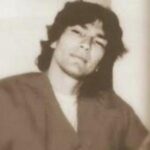“If I think about what I’ve done, it would hurt me, so I don’t think about it…If I had a choice, well, you have said we all have choices, that’s true, but at the time, I didn’t seem to have one. If I could, I would have liked to be different than what I am. I would have liked to have had a better outlook on life…but I can’t change yesterday.”
– Richard Kuklinski –
The Beginning of The Beast
It is true that the foundation we receive as children does not determine our destiny, but it does serve to shape the internal morals and values we live by. As a child, Richard Kuklinski did not know comfort. He knew fear. He did not know warmth. He knew rage. He did not know love. He knew hatred. He learned how to be completely numb in the midst of it all, beginning a lifetime of emotional paralysis.
Richard Leonard Kuklinski was born on April 11, 1935, the second of four children to Anna and Stanley Kuklinski in the rough, working class city of Jersey City, New Jersey. His father, Stanley, was a brakeman for the railroad, and his mother, Anna, worked at a meat packing plant. Stanley Kuklinski was a raging alcoholic that abused his wife and children indiscriminately (Carlo, 15). Anna Kuklinski was a strict Catholic that ruled her household with the same rigidity and impersonality as her religion. Abused by nuns and priests in the orphanage in which she lived throughout her childhood. Anna thought nothing about taking a broomstick to Richard when he displeased her.
I didn’t like my father. He would beat me whenever he felt like it. To get my attention, I guess. He would think nothing of coming in and smacking ya. Even if you just looked at him, he’d beat you. I would’ve killed him if I could’ve and I would’ve felt good doing it…my mother was a cancer. She would destroy everybody. She wouldn’t hesitate to give me a swat here or there. She didn’t just use her hands. She used a broomstick. It hurt. She broke the broom on me more than once” (HBO – “Conversations”).
To say that Kuklinski’s formative years were filled with a volatile mix of mental abuse, physical abuse, and neglect, is an understatement. At five years of age, Richard’s father killed Richard’s older brother Florian by beating him, but had his wife Anna tell authorities, family, and friends that Florian had fallen down the stairs and hit his head. Along with severe emotional trauma suffered at the hands of his parents, Kuklinski endured many random beatings in his household throughout the years. He was a target for both his parents’ anger and frustration and in turn, often abused and tortured animals to circumvent his isolation, neglect, and anger. When Stanley left the family and Richard was almost sixteen, he had become an available mark for gangs as well, often tolerating the humiliation they had dealt him through beatings on the streets of the low income housing projects in which he lived. Then one day, everything changed.
Kuklinski had taken one beating too many. After another fight with the street gang, Richard went upstairs to his apartment and grabbed a bar from the closet in which the clothes hung. He went downstairs and beat all six boys, almost to death, saying,
“I was no longer taking the beating, but giving it. That’s when I realized, it’s better to give than to receive.” After that instance, Richard Kuklinski became known and feared for his explosive temper. He hurt people whenever he felt humiliated, embarrassed, or angry. When people challenged his authority, they got hurt.
He soon committed his first murder at the age of eighteen. He had been in a pool hall and believed another young man had insulted him. He beat him to death with a cue stick outside of the pool hall. He felt badly that he had killed someone, but also felt a rush that he had been in complete control over someone. He liked that. He committed murder indiscriminately. Killing random people that irritated him with absolutely no remorse.
He met and married Barbara Pedrin while in his mid-twenties. They started a family. Being that Richard had an 8th grade education and no lucrative skills, he began work in a film lab where he learned to pirate pornographic films to sell to outside sources, most notably, the Gambino crime organization, opening up a connection to the mob. Under the watchful eye of Capo, Roy DeMeo, Kuklinski became the ultimate enforcer, a hit man for the family. DeMeo also taught Kuklinski the art of dismemberment in an apartment above the Gemini Lounge in Brooklyn, New York, dubbed “The Killing Room.” Kuklinski’s family was growing and he felt pressured to secure the type of means in which to provide a life of luxury and comfort for them. As the number one contract killer for the Gambino crime organization, Kuklinski was able to negotiate the price for each hit, and his price range grew with each year. It wasn’t long before he began asking for five figures (on the high end) for each murder.
He was arrested on May 25, 1988 a few blocks from his home by law enforcement. According to the HBO Documentary “The Iceman Tapes – Conversations With a Killer,” Kuklinski was convicted of multiple murder and sentenced to life in prison, ending a thirty year career of cold-blooded killing by a master criminal known as “The Iceman.” What happened along the way to mold Richard Kuklinski into “The Iceman?” What was it that forged him into a cold-blooded, remorseless killer?
Applying the Theories that Melt the Ice
He was called “The Iceman” because sometimes he would freeze dead bodies and then months later, place them in areas to be found. This method baffled law enforcement because there was little or no forensic evidence involved and without proper time of death, the crime was left virtually unsolved. Because of his cold demeanor and remorseless attitude about his crimes, the name “Iceman” fit him most appropriately.
Richard Kuklinski was a murderer. His murder spree spanned thirty years. He committed murder if he felt insulted, if someone irritated him, was loudmouthed, or ignorant. He committed murder for money when there was absolutely no feeling involved. He used various methods of murder, such as, shooting, strangulation, and expertly poisoning many victims with cyanide, his favorite method of killing in which he learned from Army explosive specialist, Richard Prongay. In some instances, he tortured his victims if he was paid enough to do it. In numerous interviews given and in the three documentaries created by HBO about his crimes and his personal vestment in those crimes, Kuklinski showed little remorse other than for the pain his criminal activities have caused his family. Aside from that, there is no penance, no seeking of forgiveness, and some would argue, a sense of arrogance and braggadocio that he was able to commit so many murders throughout the years without getting caught.
Going back to the root of his problems, one would point out that his start in life was a most rocky one. According to Edwin Sutherland’s Differential AssociationTheory, criminal behavior is learned behavior due to social interaction with others. This theory states that every human being is a blank slate when born and that his or her predisposition to criminal activity is formed by the influence of close, personal relationships and surroundings.
Richard Kuklinski was born an innocent, just as every human being since the beginning of time. He very well may have become a hard-nosed criminal and murderer of his own recognizance, even if reared in the most loving and nurturing environment, but I happen to agree with Edwin Sutherland in that the explosive temper and the emotional voidance Kuklinski acquired while having to survive his childhood, served to only accelerate his path to criminality. We may even look at his younger brother, Joseph Kuklinski, convicted of the rape and murder of a 12 year-old girl and sentenced to life imprisonment at Trenton State Prison (incidentally, where Richard served time before his death in 2006), as further proof that the environment and social interaction and relationships with those closest to the individual, serve as stepping-stones and foundations to the choices individuals build their lives upon.
According to online source, Criminal Justice Sources, “The Differential Association Theory, also known as, the Learning Theory, is the sociological theory that also predicts that an individual will choose a criminal path when the balance of definitions for law-breaking exceeds those for law-abiding and to a greater or lesser extent, both non-criminal and criminal individuals are motivated by the need for money and social gain. The above particular aspect of Sutherland’s theory leads directly into another theory that would also apply to Richard Kuklinski…the theory known as the Strain Theory.
According to the online source, Criminal Justice Sources, The Strain Theory, followed by the work of Emile Durkheim and further advanced and developed by Robert K. Merton, states that social structures within the society may encourage citizens to commit crimes. For example, on the individual scale of the strain, if the goals of a society become extremely important to the individual, actually achieving such goals may become more significant that adhering to the means that have been accepted by society. Merton lists five compartments of the structure of the strain and they are, Conformity, Innovation, Ritualism, Retreatism, and Rebellion. Richard Kuklinski falls into the category of Innovation because he used his own initiative to devise socially unacceptable means (he rejected the socially acceptable means) in order to achieve his goals of money, status, and luxury.
As Kuklinski went from committing murder based on personal vendettas and moved into creating a lucrative business as a contract killer for the Gambino crime organization, he became an Innovator. Previously, I stated that because Kuklinski held nothing but an 8th grade education and had no real skills for steady employment opportunities and also had a growing family that depended on him to provide for their needs, he saw committing murder for money as the means to achieve a comfortable lifestyle for the family he loved and for himself. He, in turn, spent the next thirty years committing murder for hire.
The Afterthought
Richard Kuklinski was brought to justice after negotiating a price for murder solicited by undercover Special Agent Dominick Polifrone. Richard Kuklinski died on March 5, 2006. At the time of Kuklinski’s death, authorities had linked him with absolution to at least fifty unsolved homicides. In the three documentaries developed by HBO, one in which he discusses his criminal activities with renown forensic psychologist, Dr. Park Dietz (most noted for interviewing and analyzing Jeffrey Dahmer), Kuklinski admitted to having killed perhaps even more than 200 people. Kuklinski also admitted to having physically and mentally abused his wife, Barbara, proof that his life had come, as he so cryptically murmered,
“full circle.”
Richard Kuklinski was just one tragedy of a life doomed to failure at the very start. Granted, the majority of people that have suffered abuse and trauma as children do not grow up to become serial, contract murderers, but I also cannot help but wonder what his life may have been had he received the love that every child deserves. Would he have still been, “The Iceman,” or would he have been just, Richard Leonard Kuklinski, loyal, loving, trusting husband and wonderful, nurturing father? We will never know the answers to such questions because there is never going to be concrete evidence to support that argument, but let the numbers of those incarcerated that were abused, pressured, and forced to make the wrong choices because that was all they had ever known, speak for themselves.
“Little by little, Stanley was, in effect, beating the very necessary human elements of compassion and empathy out of his second-born, clearly delineating the path Richard’s life would ultimately take.”
– Philip Carlo, author of “The Iceman – Confessions of a Mafia Contract Killer”
Works Cited
Carlo, Philip. The Iceman – Confessions of a Mafia Contract Killer. New York: Martin’s
Press, 2006.
Criminal Justice Sources. Criminology. Demelo’s Differential Association. 10 Apr.
2005. 27 Nov. 2007 http://www.acs.appstate.edu/dept/ps-cj/cj-sour.html
“The Iceman: Conversations With a Killer.” America Undercover. Dir. Arthur
Ginsberg. Prod. Jim Thebaut. HBO. 1992.
“The Iceman Confesses: Secrets of a Mafia Hitman.” America Undercover. Dir.
Arthur Ginsberg. Prod. Gary Monet. HBO. 2001.
“The Iceman and the Psychiatrist.” America Undercover. Dir. Arthur Ginsberg. Prod.
Gary Monet. HBO. 2003.






